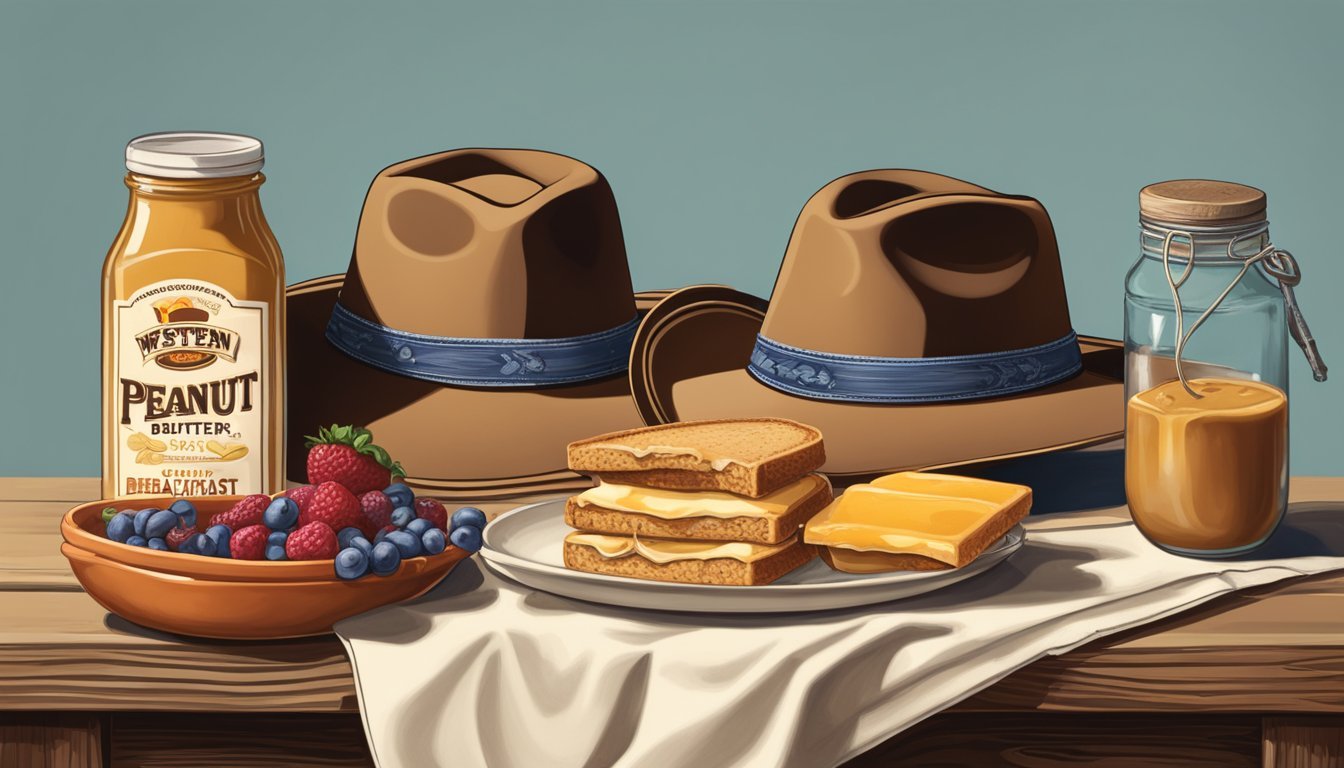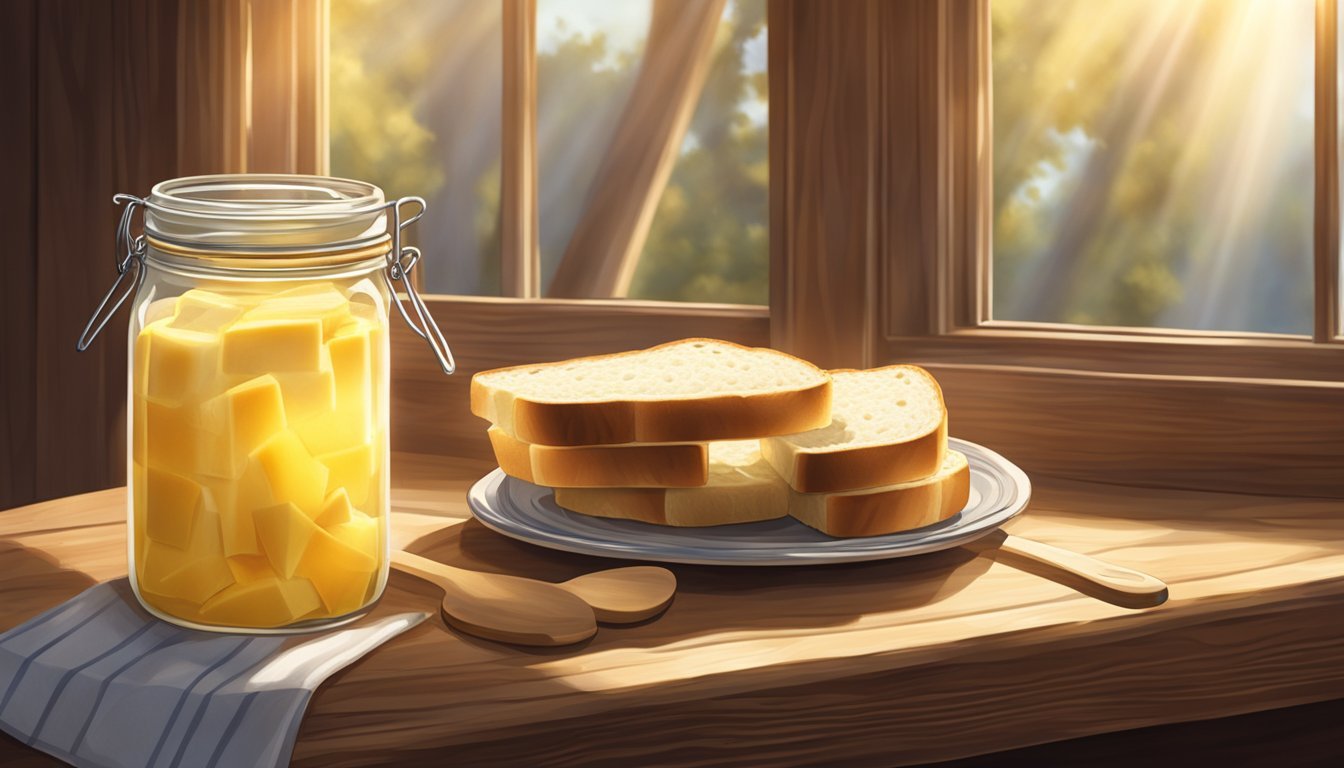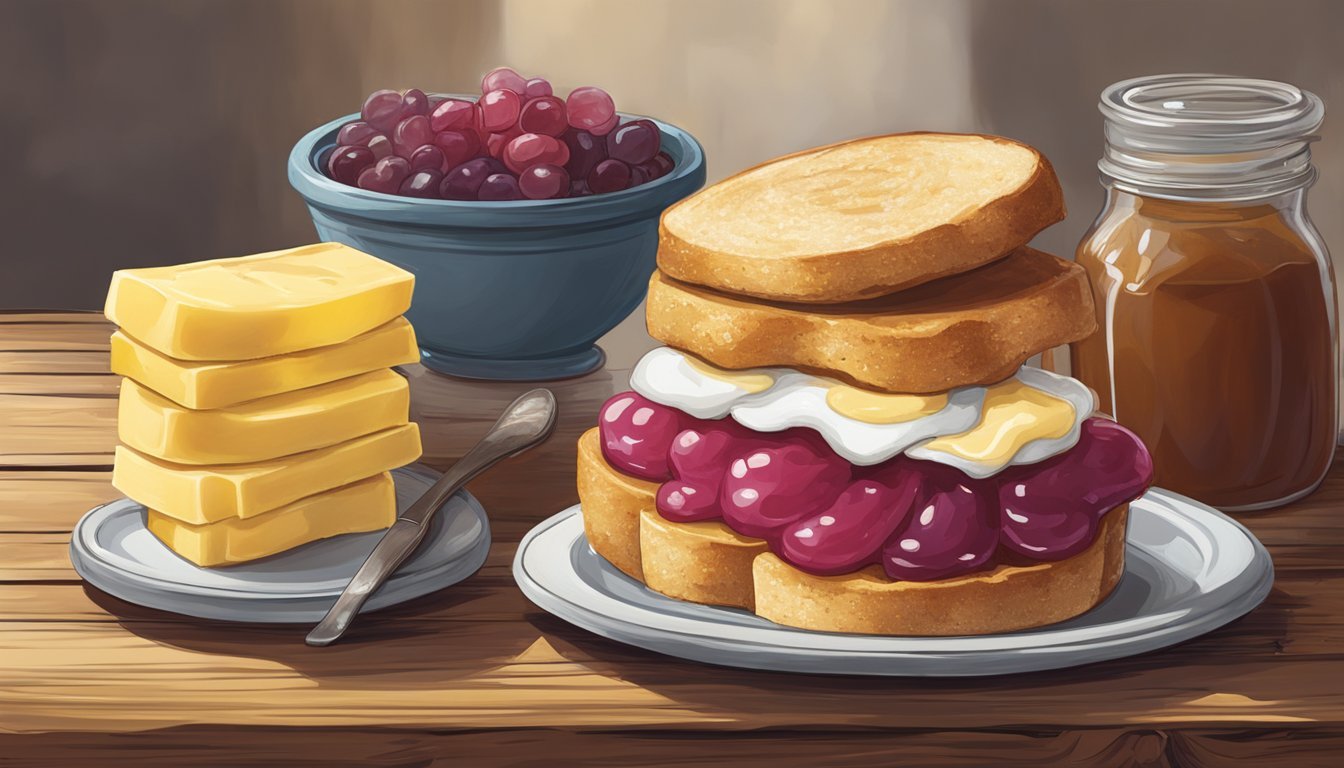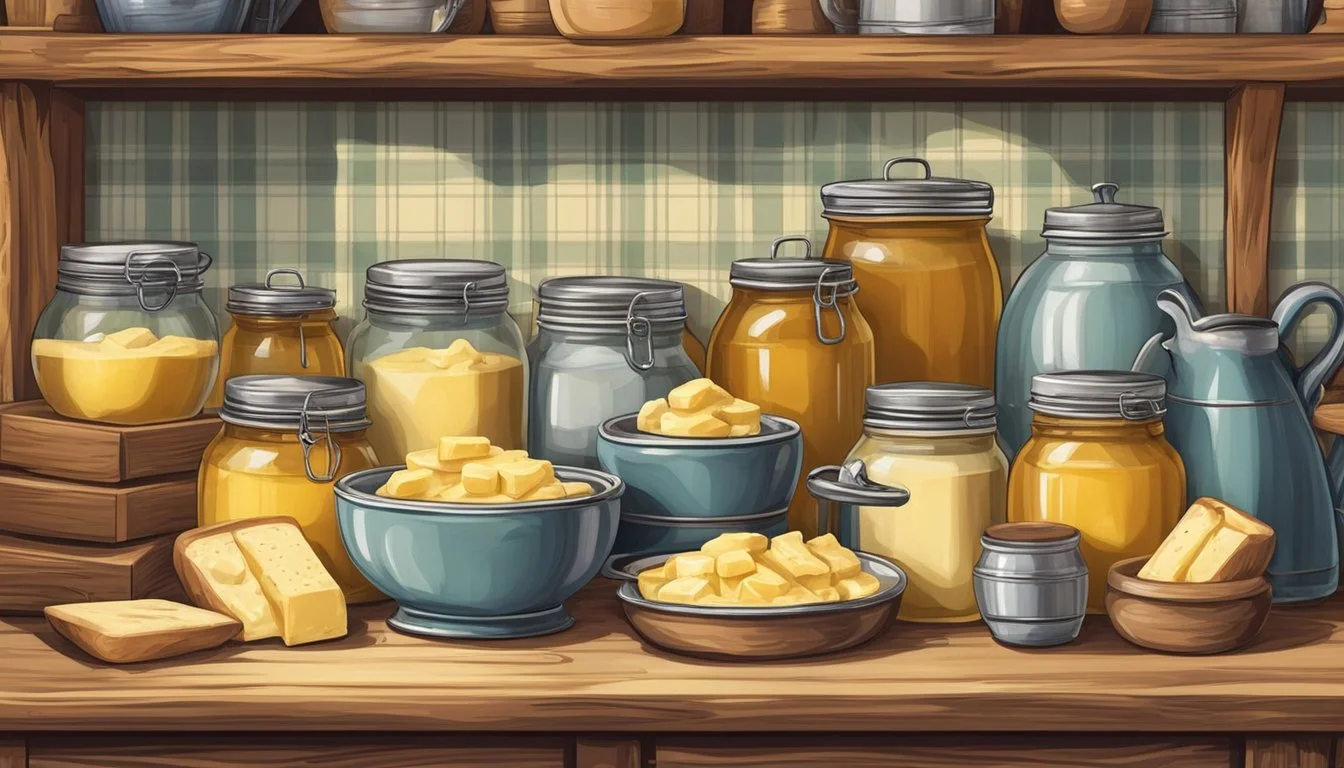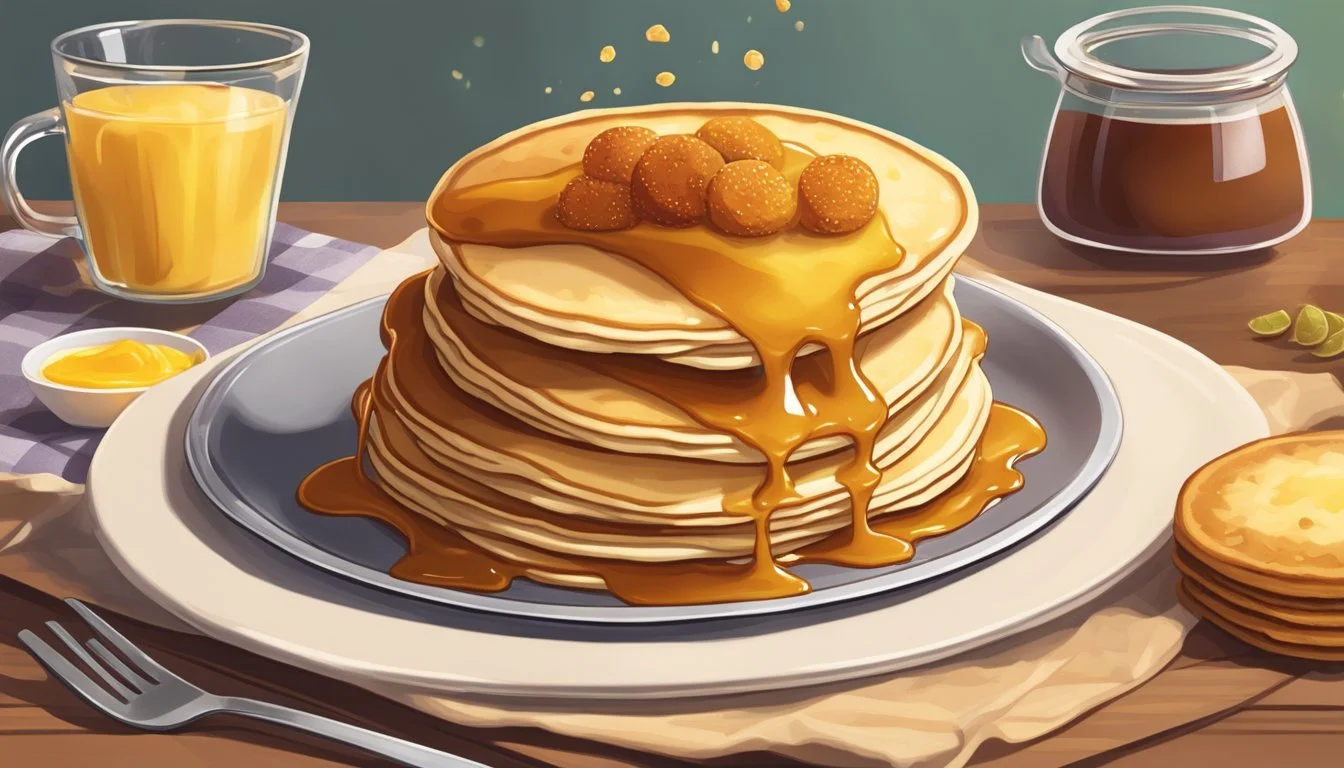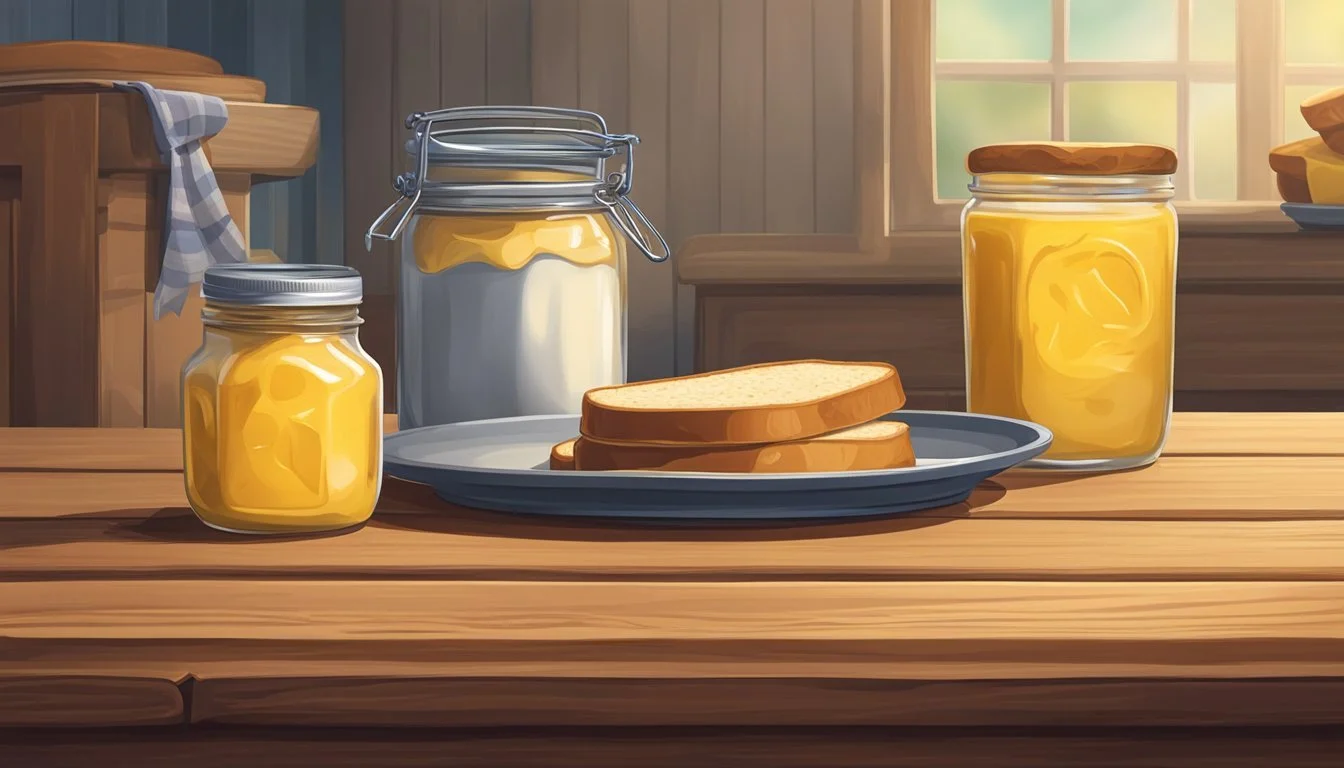Cowboy Butter Jelly
The Perfect Blend for an Unforgettable Morning Spread
Cowboy butter has charged onto the culinary scene as a flavorful game changer for epicureans in search of a bold taste adventure. Originally seen as an accompaniment for grilled steaks, this compound butter has transcended its Texan steakhouse origins to become a versatile kitchen staple. Cowboy butter combines the richness of traditional butter with a dynamic mix of herbs, spices, and aromatics, offering a complex profile of flavors with a subtle kick that elevates the taste of any dish it graces.
The allure of cowboy butter lies in its harmonious balance of ingredients such as garlic, hearty herbs like parsley and chives, a hint of acid from lemon, and the spirited punch of spices including smoked paprika and chili. Its popularity has surged due to its simplicity and adaptability; each component playing a crucial role without overpowering the others. As such, this condiment pairs well not only with meats but also as a tasteful addition to vegetable dishes, warm bread, and now, as an innovative twist atop morning toast in the form of cowboy butter jelly.
History and Origin of Cowboy Butter
Cowboy butter is a flavorful compound butter that has gained popularity for its rich taste and versatility in enhancing various dishes. It combines butter with a unique blend of spices, herbs, and sometimes citrus elements, resulting in a savory topper ideal for breakfast and more.
Influences and Evolution
The roots of cowboy butter can be traced to the concept of compound butter, a culinary creation well-established in French cuisine. Compound butters have been used for centuries to quickly add flavor to dishes, made by mixing unsalted butter with various ingredients such as herbs, spices, and garlic.
Cowboy butter recipe specifically is not attributed to a single inventor; rather, it is a blend of traditional compound butter with a twist that reflects American culinary spirit. It is most notably popularized by food personalities like Ree Drummond, also known as The Pioneer Woman, through her cooking show and blog. Drummond played a significant role in introducing cowboy butter to a broader audience, making it synonymous with a country-style flavor profile fitting for a range of dishes, from grilled meats (What wine goes well with grilled meats?) to breakfast favorites.
As cowboy butter recipe circulates through social media and cooking channels, it evolves with numerous variations. Home cooks and chefs alike continue to experiment with the recipe, adding their personal touches and adapting it to modern tastes.
Cowboy Butter: Understanding the Basics
Cowboy Butter elevates the flavor of traditional butter, incorporating a blend of spices, herbs, and other components that transform it into a versatile spread. It is known for its robust flavor and the ability to complement a variety of dishes.
Defining Compound Butter
Compound butter is a mixture of unsalted butter and supplementary ingredients such as herbs, spices, and aromatics. Its purpose is to enhance flavor and can be used both as a spread and a cooking ingredient. Cowboy Butter falls within this category, bringing a unique twist with its specific ingredients that cater to those who appreciate a spicy and aromatic flavor profile.
Key Characteristics of Cowboy Butter
The ingredients of Cowboy Butter typically include:
Garlic: Adds a pungent, savory flavor.
Fresh herbs: Such as parsley and chives provide a fresh, grassy notes.
Dijon mustard: Contributes a tangy depth and slight heat.
Lemon zest: Offers a bright citrus element.
Cayenne pepper and black pepper: Deliver a warm, spicy kick.
The defining feature of Cowboy Butter is its rich, complex taste that can transform a simple meal into a more flavorful experience. This compound butter is commonly served as a melt-over sauce for steaks, but it can also be used to enhance the taste of vegetables, bread, and other foods. Its versatility makes it a favorite for those who wish to add a bold touch to their cooking.
Preparation Guide
This section provides a concise guide to creating Cowboy Butter Jelly, a unique and savory condiment that can elevate the flavor profile of any breakfast dish.
Ingredients List
To prepare Cowboy Butter Jelly, one will need the following ingredients:
Unsalted butter: 1 cup (softened)
Garlic: 3 cloves (minced)
Parsley: ¼ cup (finely chopped)
Cayenne pepper: ¼ teaspoon
Lemon zest: From 1 lemon
Lemon juice: 3 tablespoons
Dijon mustard: 1 tablespoon
Smoked paprika: 1 teaspoon
Kosher salt: ½ teaspoon
Black pepper: ½ teaspoon
Horseradish: 1 tablespoon (optional)
Worcestershire sauce: 1 teaspoon
Step-by-Step Instructions
Combine Dry Ingredients: In a medium mixing bowl, thoroughly mix together the minced garlic, chopped parsley, cayenne pepper, lemon zest, smoked paprika, kosher salt, and black pepper.
Incorporate Wet Ingredients: To the dry mixture, add the softened unsalted butter, lemon juice, Dijon mustard, optional horseradish, and Worcestershire sauce. Stir until all components are well combined and the mixture is uniform.
Shape: Transfer the butter mixture onto a large sheet of plastic wrap or parchment paper. Roll the mixture into a log shape, pressing and shaping as needed.
Chill: Twist the ends of the wrap or paper and place the log in the refrigerator until firm, typically 1-2 hours, to allow the flavors to meld and the butter to solidify.
Recipe Variations and Substitutions
For a spicier kick, one may increase the cayenne pepper to taste or add crushed red pepper flakes.
If one prefers a tangier flavor, additional lemon zest or juice can be incorporated.
Should one desire a different herb profile, consider substituting the parsley with other fresh herbs such as chives or thyme.
For those avoiding dairy, try using a dairy-free butter substitute to maintain the characteristic richness without actual butter.
Serving Suggestions
Cowboy Butter Jelly is a dynamic and flavorful topper that can turn an ordinary breakfast into an extraordinary meal. Packed with a harmonious blend of herbs and spices, it serves as a versatile enhancement to a variety of dishes.
Recommended Pairings
Steak: A dollop of Cowboy Butter Jelly melts over a hot steak, creating a rich sauce that highlights the savory flavors of the meat.
Grilled Meat: Whether it's chicken, pork, or other meats, the jelly adds a burst of flavor that complements the charred, smoky taste.
Seafood: This jelly pairs exceptionally well with grilled fish and shrimp, lending a zestful twist to seafood dishes. (What wine goes well with seafood dishes?)
Bread: Spread on toast, bagels, or biscuits, it transforms regular bread into a delectable treat with an herbaceous kick.
Vegetables: Sautéing veggies such as beans, potatoes, or mixed garden vegetables with a spoonful of Cowboy Butter Jelly enhances their natural flavors.
Creative Uses as a Condiment
Dipping Sauce: It's perfect as a dipping sauce for everything from raw veggies to tempura.
Sauce Base: Utilizing Cowboy Butter Jelly as a base in creating other sauces can introduce a complex flavor profile to any dish.
Spread: An imaginative chef might use it as a hearty spread in a gourmet sandwich, pairing it with other fresh ingredients for a truly special lunchtime experience.
Storage and Preservation
Proper storage is critical for maintaining the taste and shelf life of Cowboy Butter Jelly. By adhering to the best practices in refrigeration and freezing, one can ensure that their delightful condiment remains a flavorful addition to breakfasts for as long as possible.
Refrigeration Tips
Containers: Always store Cowboy Butter Jelly in an airtight container to preserve freshness and prevent absorption of other food odors.
Temperature: The fridge should be set to maintain a constant temperature below 40°F (4°C) to inhibit bacterial growth.
Freezing Instructions
Preparation: Divide the jelly into usable portions before freezing to avoid repeated freeze-thaw cycles.
Containers: Use airtight containers or heavy-duty freezer bags to protect from freezer burn.
Duration: When properly stored, Cowboy Butter Jelly can be kept in the freezer for up to 3 months for optimal taste.
Health and Nutrition
Cowboy Butter Jelly can offer flavor depth to breakfast options; however, understanding its health and nutritional impact is crucial for making informed dietary choices.
Nutritional Profile
Cowboy Butter Jelly typically combines butter—a dairy product rich in fats—and additional components like garlic, herbs, and occasionally sugar, depending on the recipe variation. The nutritional profile of a standard serving (1 tablespoon) can be summarized as follows:
Calories: Approximately 100 kcal
Fat: 11 g
Saturated fat: About 7 g
Polyunsaturated fat: Minimal
Trans fat: Negligible, unless using margarine or hydrogenated oils
Cholesterol: Around 30 mg
Sodium: Roughly 90 mg
Carbohydrates: Less than 1 g
Fiber: 0 g
Sugar: Varies, could be 0 g unless sweetened
Protein: Negligible
This data suggests that while Cowboy Butter Jelly could be considered high in saturated fat and cholesterol, it is low in carbohydrates and sugars, unless additional sweeteners are used.
Dietary Considerations
When incorporating Cowboy Butter Jelly into a diet, several considerations should be taken into account:
Heart Health: The presence of saturated fat and cholesterol may raise concerns for individuals monitoring their heart health; moderation is key.
Weight Management: Due to high-calorie density, portion control should be exercised for those mindful of their energy intake.
Low-Carb Diet Compatibility: The typical low carbohydrate content makes this jelly suitable for low-carb dietary patterns.
Dairy Allergies or Lactose Intolerance: As butter is a dairy product, it may not suit individuals with lactose intolerance or dairy allergies.
Reduced Sodium Options: Salted butter can contribute to higher sodium levels; opting for unsalted butter may be preferable for sodium-conscious consumers.
Enhancing Flavors and Textures
To ensure the Cowboy Butter Jelly is both delightful and distinct, one must pay attention to the selection of ingredients and their preparation. The manipulation of texture and incorporation of flavors are pivotal to the culinary success of the jelly.
Selecting the Right Ingredients
The foundation of Cowboy Butter Jelly relies on high-quality butter, which is complemented by a careful selection of spices to create a rich flavor profile. Ingredients should include:
Butter: Unsalted, to control the sodium content.
Spices: A balanced blend of smoked paprika for depth, black pepper for sharpness, and kosher salt for enhanced taste.
Herbs: Fresh herbs, as they provide a brighter flavor compared to their dried counterparts.
Adjusting Spice Levels
To cater to different palates, one can adjust the intensity of the Cowboy Butter Jelly by manipulating spice levels. This involves:
Crushed Red Pepper Flakes: For a bold kick, incorporate a generous pinch; lessen the quantity for a milder taste.
Cayenne Pepper: Add a small amount to introduce a subtle heat, increasing as desired for a fiercer profile.
Incorporating Fresh vs Dried Herbs
The texture and flavor intensity of herbs dramatically influence the overall sensory experience of the Cowboy Butter Jelly. It is essential to consider:
Fresh Herbs: Introduce them finely chopped for a fresh, vibrant aroma and a brighter taste.
Dried Herbs: Use sparingly, as they pack a more concentrated flavor, impacting the jelly's texture and taste.
Cowboy Butter in Professional Cooking
In professional kitchens, cowboy butter is renowned for its versatility and flavor-enhancing capabilities. Chefs utilize it as a condiment, a cooking medium, and a key ingredient for innovating menus.
Chefs' Techniques and Tips
Professional cooks often incorporate cowboy butter into their dishes to introduce a blend of rich buttery taste and aromatic spices. They typically create cowboy butter by mixing melted butter with a variety of spices like garlic, parsley, chives, smoked paprika, and a hint of citrus from lemon zest and juice. This combination makes the butter exceptionally flavorful. Chefs may use it in its solid state to top steaks or melted as a dip for bread and vegetables. Employing cowboy butter also allows cooks to add depth to their sauces, thereby layering flavors in a dish.
Key Techniques Include:
Blending: Thoroughly mixing spices with softened butter for uniform flavor distribution.
Chilling: Rolling the mixed butter into logs using parchment paper and refrigerating until firm for easy slicing.
Melting: Gently melting the butter for use as a dipping sauce.
Menu Innovation Using Cowboy Butter
Chefs have been pioneering menu items with cowboy butter, using it as a foundational element for creating innovative, mouthwatering dishes. Cowboy butter can transform a simple meal into a memorable culinary experience, as it pairs well with various proteins and vegetables. Menus can feature it prominently in:
Meat Dishes: Brushing steaks or chicken with cowboy butter during or after cooking to boost moisture and richness.
Seafood: Drizzling over grilled fish or shrimp to complement their natural flavors.
Vegetarian Options: Enhancing the taste of grilled or roasted veggies with a dollop of spiced butter.
A typical Innovative Menu might include:
Starter: Artisan Bread with Cowboy Butter
Main: Cowboy Butter-Basted Ribeye Steak (What wine goes well with ribeye steak?)
Side: Roasted Root Vegetables Topped with Cowboy Butter
Chefs appreciate cowboy butter for its ability to elevate both the flavor profile and visual appeal of their dishes, ensuring a dynamic and enjoyable dining experience.
Homemade Vs. Store-Bought
When considering Cowboy Butter Jelly as a breakfast food, one must weigh the distinctions between homemade and store-bought options, focusing on both quality and cost.
Comparing Quality and Taste
In terms of ingredient quality, homemade Cowboy Butter Jelly typically affords the cook control over the selection of simple ingredients, leading to a fresher and more personalized flavor profile. The flavor and texture of homemade versions are often deemed superior due to the absence of preservatives and the use of freshly sourced ingredients.
Homemade: Enhances flavor with fresh, chosen herbs and spices.
Store-Bought: May include preservatives affecting texture and taste.
Economic Considerations
The economic considerations of homemade compared to store-bought Cowboy Butter Jelly hinge on the long-term costs versus immediate convenience. While store-bought may appear cheaper upfront, making Cowboy Butter Jelly at home can be more cost-effective over time, especially if bulk ingredients are purchased.
Homemade: Potentially lower cost over time; requires initial investment for ingredients.
Store-Bought: Lower initial cost but may be more expensive in the long run.
Cowboy Butter on Social Media
Cowboy Butter has emerged as a culinary phenomenon on various social media platforms, with inventive recipes and community engagement driving its popularity.
Popular Recipes and Trends
On platforms such as Instagram and TikTok, food enthusiasts have shared an array of Cowboy Butter recipes. These creations often pair the butter with steak, lauding it as a transformative sauce that enhances flavor. As a reflection of the social media trend, certain recipes featuring Cowboy Butter have amassed views in the millions. These platforms have played a pivotal role in not only spreading awareness but also in showcasing innovative uses for Cowboy Butter in everyday cooking.
TikTok: Over 67 million views for Cowboy Butter content
Instagram: Visual posts highlighting Cowboy Butter's versatility as both a topping and a dip
Sharing and Community Engagement
Social media has fostered an interactive community where individuals can instantly share their culinary experiments with Cowboy Butter. Users frequently engage by posting comments, sharing their own takes on recipes, and offering personal modifications or serving suggestions. This level of interaction has not only fueled the spread of Cowboy Butter as a trend but also cemented its status as a communal favorite in the digital space.
Community Interactions: Comments, recipe swaps, and tips for serving
Platforms: Instagram Stories and TikTok videos are hotspots for engagement
Frequently Asked Questions
This section addresses common queries about Cowboy Butter Jelly, providing practical advice for first-time makers, along with tips for preparation and storage.
Addressing Common Concerns
Q: What is the approximate prep time for making Cowboy Butter Jelly?
A: The prep time may vary, but typically it can take around 15 to 20 minutes to prepare the ingredients before cooking.
Q: Which spices are commonly used in Cowboy Butter Jelly?
A: Key spices include garlic, crushed red pepper, paprika, and sometimes cumin or fresh herbs.
Q: Can Cowboy Butter Jelly be stored in the freezer?
A: It is not recommended to freeze Cowboy Butter Jelly, as it may affect the texture and flavor. Instead, it can be stored in the refrigerator.
Q: What temperature should Cowboy Butter Jelly be served at?
A: Cowboy Butter Jelly can be enjoyed warm as a melt-over topper or chilled, similar to traditional compound butter.
Tips for First-Timers
Preparation: Ensure that all ingredients are at room temperature before blending, to create a smooth mixture.
Taste Testing: Always taste your Cowboy Butter Jelly before serving and adjust spices as needed.
Usage: Consider Cowboy Butter Jelly versatile; it works excellently on toast, but one can also explore it as a topper for pancakes, waffles, or even savory dishes.
Varied Applications of Cowboy Butter
Cowboy Butter, a robust and flavorful condiment, proves itself to be remarkably versatile. Primarily known for its role in enhancing breakfast dishes, it serves multiple purposes across an array of meals.
Beyond Breakfast: Other Meal Transitions
Lunch Spotlight:
Cowboy Butter elevates the simplest sandwiches, wraps, and paninis. Its bold mix of garlic and herbs pairs perfectly with turkey, ham, and even vegetarian options, transforming the midday meal into a gourmet experience.
Burgers and Hot Dogs: With a dollop of Cowboy Butter, one can impart a garlic-infused twist to the classic cookout staples.
Salad Dressing Base: When emulsified with vinegar and oil, it becomes a hearty dressing that complements leafy greens and pasta salads.
Dinner Enhancement:
As the day progresses to more elaborate culinary endeavors, Cowboy Butter seamlessly transitions into dinner as a finishing sauce for proteins like steak, chicken, and seafood. It also excels as a:
Pasta Enhancer: When tossed with freshly cooked pasta, it melts into a rich sauce, blending beautifully with the warmth of the noodles.
Vegetable Topping: A pat of Cowboy Butter on steamed or grilled vegetables can replace traditional herbed butters for added depth of flavor.
Versatile Dip and Spread:
Cowboy Butter's role extends into the realm of dips and spreads, serving as a distinctive complement to:
Bread Accompaniment: It’s a natural fit as a spread on freshly baked bread or toast, infusing each bite with garlicky, herbed notes.
Dip for Appetizers: Whether it’s for a crusty baguette or crudités, it offers a spicy and tangy dip option that stands out on the appetizer table.
In every application, Cowboy Butter acts not just as an add-on but as an essential enhancement that shifts an ordinary meal into an expression of culinary artistry. It showcases its multitasking prowess as a sauce, dip, spread, and condiment, equally at home smeared on a breakfast toast or melted over an evening steak.
Closing Thoughts
Cowboy butter, an indulgent and flavorful addition to any breakfast repertoire, marries the robustness of classic spices and the zest of citrus in a harmonious spread. It should not be mistaken for jelly in its traditional sense, as it is actually a compound butter with a unique twist that can elevate morning toasts, pancakes, or even savory breakfast biscuits.
The Recipe for this gourmet butter is straightforward and open to customization. Typically, it calls for:
Unsalted butter
Fresh herbs (parsley, chives)
Spices (crushed red pepper, smoked paprika)
Lemon zest and juice
Garlic, finely minced
Key Steps include:
Softening the butter to ensure a smooth blend.
Finely mincing garlic and herbs for even distribution.
Carefully incorporating all ingredients for a cohesive flavor profile.
Users should remember to adjust according to palate preference; the spice levels and the intensity of citrus can be tuned to suit different tastes. Store it properly, and it becomes a convenient and versatile condiment.
The novelty of cowboy butter lies in its rustic charm and ease of preparation. While traditional jellies are sweet, this "cowboy" variant imparts depth with its savory notes, making it a must-try for those seeking an adventurous twist to their breakfast. As always, quality ingredients take precedence in achieving the best taste and texture. When preparing it, they approach the process with confidence; experimenting with the recipe can lead to delightful variations personalized to one's liking.
Appendix
The Appendix provides supplemental resources for readers who wish to explore the Cowboy Butter Jelly recipe further. These resources are aimed at enhancing one's understanding of the recipe and its applications.
Additional Resources
Online Culinary Guides: Readers can access various culinary websites and food blogs for in-depth tutorials and alternative Cowboy Butter Jelly recipes.
Cookbooks: Several gourmet cookbooks include recipes for compound butters and unique breakfast toppers that can inspire further experimentation.
Cooking Workshops: Local and online cooking classes may offer sessions focused on creating flavored butters and jellies, providing hands-on experience.
Ingredient Suppliers: Specialty stores, both online and brick-and-mortar, may carry high-quality ingredients required for the recipe.

